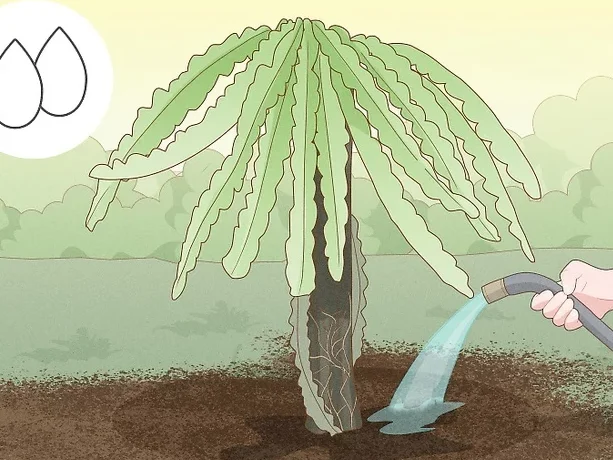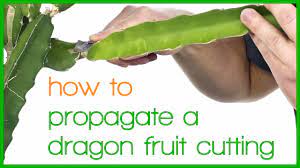Dragonfruit Growing Tips: In the realm of exotic fruits, the dragon fruit, also known as pitaya or pitahaya, stands as a captivating specimen that beckons both enthusiasts and horticulturists alike. The allure of its vibrant hues and unique shape is matched only by the satisfaction of cultivating this mesmerising fruit successfully. However, embarking on the journey of dragon fruit cultivation demands an understanding of the nuanced process of growing dragon fruit. Let’s delve into the intricacies of fostering these otherworldly plants.
Table of Contents
Important Dragonfruit Growing Tips

Choosing the Right Location
The first step towards fostering a thriving dragon fruit plantation involves selecting an optimal location. Dragon fruits, being native to tropical regions, crave warmth and sunlight. Full sun exposure is paramount for their growth, with a preference for at least six hours of sunlight daily. It’s advisable to shield them from harsh winds, as these can be detrimental to the delicate balance dragon fruits seek.
Soil Composition
Conditions to grow dragon fruit extend beneath the surface, emphasising the significance of soil composition. Dragon fruits flourish in well-draining soil, and a sandy loam or cactus mix proves to be an ideal choice. Ensuring a slightly acidic to neutral pH, ranging from 6 to 7, fosters an environment conducive to their development. This meticulous attention to soil quality lays the groundwork for a fruitful harvest.

Temperature
Dragon fruits exhibit remarkable resilience to high temperatures, yet they do have their limits. Thriving in temperatures between 65 and 80 degrees Fahrenheit (18 and 27 degrees Celsius), they might endure brief spells outside this range. However, prolonged exposure to frost or scorching conditions can compromise their health. A vigilant eye on the thermometer becomes an ally in maintaining the perfect thermal haven for these celestial fruits.

Watering
Water, the elixir of life for plants, plays a pivotal role in dragon fruit cultivation. Striking the right balance is crucial—neither drowning the roots nor subjecting them to arid conditions. A judicious approach involves regular, deep watering, especially during the growing season. Conversely, as winter approaches, curtailing the watering frequency prevents the risk of root rot. It’s a delicate dance that mirrors the natural rhythms that dragon fruits embrace.
Support Structures
Dragon fruit plants, with their climbing tendencies, benefit immensely from structured support. In their native habitats, these epiphytic cacti often cling to trees. For cultivation, providing them with trellises or sturdy support structures allows the plants to flourish, ensuring that the pendulous branches laden with fruit have a secure foundation. This method not only aids in the fruit-bearing process but also adds an aesthetic dimension to the plantation.

Feeding the Dragon
Fertilisation proves to be a pivotal aspect of dragon fruit care. Employing a balanced, water-soluble fertiliser with a composition such as 10-10-10 or 8-4-6 serves as a nourishing elixir for these unique plants. The feeding regimen should be implemented during the growing season, tapering off as winter approaches. This strategic approach aligns with the natural growth cycles of dragon fruit, promoting robust health and bountiful harvests.

Pruning
Pruning, often an overlooked art in gardening, assumes paramount importance in dragon fruit cultivation. It’s not merely about aesthetics; pruning fosters a healthier, more productive plant. Removing damaged or excess growth channels the plant’s energy into fruit production. As a best practice, pruning the tips of new growth stimulates branching, creating a denser, more robust canopy—essential for prolific fruit-bearing.
Pests
The dragon fruit, though resilient, is not impervious to challenges. Vigilance against common pests like aphids, scale insects, or spider mites is crucial. Applying neem oil or introducing natural predators helps maintain a balanced ecosystem. Additionally, keeping a watchful eye for signs of diseases like fungal infections or bacterial rot ensures early intervention, preventing potential devastation to the plantation.

Propagation
Unravelling the mysteries of dragon fruit cultivation extends to the realm of propagation. While dragon fruits are typically grown from seeds, the more common and efficient method involves stem cuttings. Snipping a healthy segment, allowing it to callus, and then planting it in well-draining soil kickstarts the journey of a new dragon fruit plant. This propagation technique not only ensures genetic consistency but also expedites the time to harvest.
Conclusion
In the intricate dance of horticulture, cultivating dragon fruit emerges as a rewarding pursuit. From the sun-soaked expanses they crave to the minutiae of soil composition and watering rituals, understanding the nuanced conditions to grow dragon fruit is akin to deciphering nature’s own code. Armed with this knowledge, enthusiasts can embark on a journey that promises not just a bountiful harvest but an intimate connection with the enigmatic allure of these celestial fruits.
